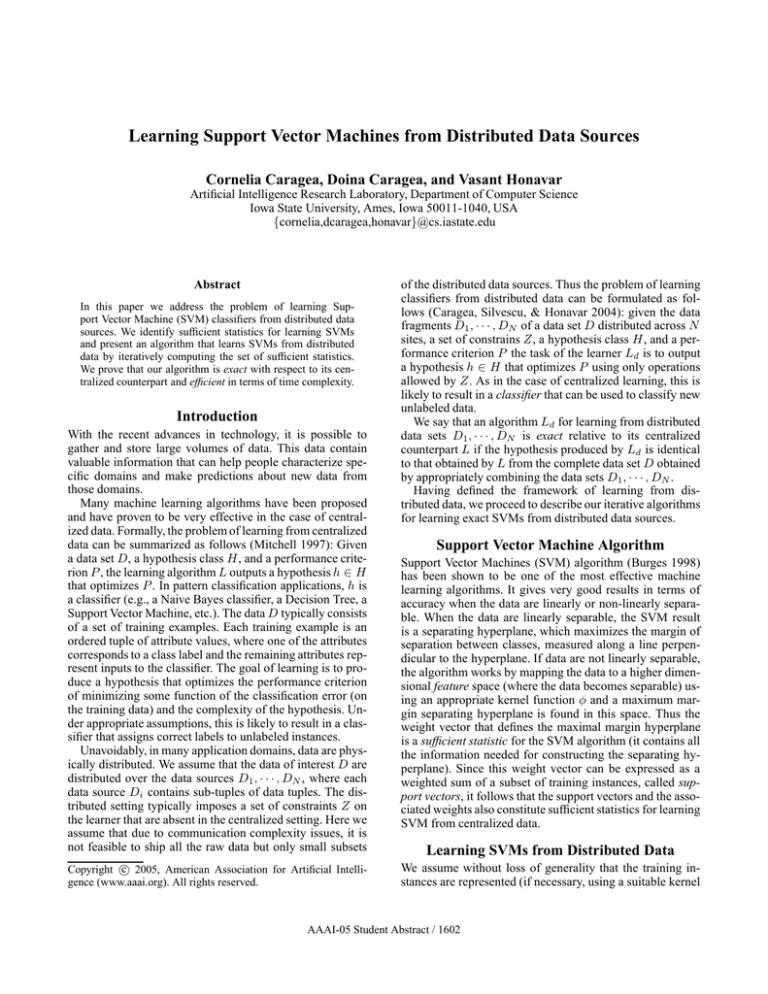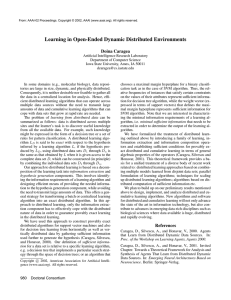Learning Support Vector Machines from Distributed Data Sources
advertisement

Learning Support Vector Machines from Distributed Data Sources
Cornelia Caragea, Doina Caragea, and Vasant Honavar
Artificial Intelligence Research Laboratory, Department of Computer Science
Iowa State University, Ames, Iowa 50011-1040, USA
{cornelia,dcaragea,honavar}@cs.iastate.edu
Abstract
In this paper we address the problem of learning Support Vector Machine (SVM) classifiers from distributed data
sources. We identify sufficient statistics for learning SVMs
and present an algorithm that learns SVMs from distributed
data by iteratively computing the set of sufficient statistics.
We prove that our algorithm is exact with respect to its centralized counterpart and efficient in terms of time complexity.
Introduction
With the recent advances in technology, it is possible to
gather and store large volumes of data. This data contain
valuable information that can help people characterize specific domains and make predictions about new data from
those domains.
Many machine learning algorithms have been proposed
and have proven to be very effective in the case of centralized data. Formally, the problem of learning from centralized
data can be summarized as follows (Mitchell 1997): Given
a data set D, a hypothesis class H, and a performance criterion P , the learning algorithm L outputs a hypothesis h ∈ H
that optimizes P . In pattern classification applications, h is
a classifier (e.g., a Naive Bayes classifier, a Decision Tree, a
Support Vector Machine, etc.). The data D typically consists
of a set of training examples. Each training example is an
ordered tuple of attribute values, where one of the attributes
corresponds to a class label and the remaining attributes represent inputs to the classifier. The goal of learning is to produce a hypothesis that optimizes the performance criterion
of minimizing some function of the classification error (on
the training data) and the complexity of the hypothesis. Under appropriate assumptions, this is likely to result in a classifier that assigns correct labels to unlabeled instances.
Unavoidably, in many application domains, data are physically distributed. We assume that the data of interest D are
distributed over the data sources D1 , · · · , DN , where each
data source Di contains sub-tuples of data tuples. The distributed setting typically imposes a set of constraints Z on
the learner that are absent in the centralized setting. Here we
assume that due to communication complexity issues, it is
not feasible to ship all the raw data but only small subsets
c 2005, American Association for Artificial IntelliCopyright gence (www.aaai.org). All rights reserved.
of the distributed data sources. Thus the problem of learning
classifiers from distributed data can be formulated as follows (Caragea, Silvescu, & Honavar 2004): given the data
fragments D1 , · · · , DN of a data set D distributed across N
sites, a set of constrains Z, a hypothesis class H, and a performance criterion P the task of the learner Ld is to output
a hypothesis h ∈ H that optimizes P using only operations
allowed by Z. As in the case of centralized learning, this is
likely to result in a classifier that can be used to classify new
unlabeled data.
We say that an algorithm Ld for learning from distributed
data sets D1 , · · · , DN is exact relative to its centralized
counterpart L if the hypothesis produced by Ld is identical
to that obtained by L from the complete data set D obtained
by appropriately combining the data sets D1 , · · · , DN .
Having defined the framework of learning from distributed data, we proceed to describe our iterative algorithms
for learning exact SVMs from distributed data sources.
Support Vector Machine Algorithm
Support Vector Machines (SVM) algorithm (Burges 1998)
has been shown to be one of the most effective machine
learning algorithms. It gives very good results in terms of
accuracy when the data are linearly or non-linearly separable. When the data are linearly separable, the SVM result
is a separating hyperplane, which maximizes the margin of
separation between classes, measured along a line perpendicular to the hyperplane. If data are not linearly separable,
the algorithm works by mapping the data to a higher dimensional feature space (where the data becomes separable) using an appropriate kernel function φ and a maximum margin separating hyperplane is found in this space. Thus the
weight vector that defines the maximal margin hyperplane
is a sufficient statistic for the SVM algorithm (it contains all
the information needed for constructing the separating hyperplane). Since this weight vector can be expressed as a
weighted sum of a subset of training instances, called support vectors, it follows that the support vectors and the associated weights also constitute sufficient statistics for learning
SVM from centralized data.
Learning SVMs from Distributed Data
We assume without loss of generality that the training instances are represented (if necessary, using a suitable kernel
AAAI-05 Student Abstract / 1602
function) in a (feature) space in which data D = ∪N
k=1 Dk is
linearly separable.
A naive approach to learning SVMs from distributed data
(Syed, Liu, & Sung 1999) works as follows: apply the SVM
algorithm for each data source Dk (k = 1, N ), and send
the resulting support vectors SVk (k = 1, N ) to the central
location. At the central location, apply SVM algorithm to
∪N
k=1 SVk . Use the final set of support vectors and their corresponding weights to generate the separating hyperplane.
Although this algorithm may work reasonably well in
practice if the data sets D1 , · · · , DN are individually representative of the entire set D, if that is not the case, Caragea
et al. (Caragea, Silvescu, & Honavar 2000) showed that
N
SV (∪N
k=1 Dk ) 6= SV (∪k=1 SVk ), i.e. union of the set of
support vectors obtained from each data source does not represent sufficient statistics for the learning from distributed
data. Thus, the naive approach to learning SVM from distributed data is not exact.
Caragea, Silvescu, & Honavar (2000) showed that the
convex hulls of the instances that belong to the two
classes represent sufficient statistics for learning SVMs from
distributed data. Let V Conv(D) denote the training instances that uniquely define the convex hull of the convex set D. The algorithm for learning SVMs from distributed data using convex hulls works as follows: compute
V Conv(Dk (+)) and V Conv(Dk (−)) for each data source
Dk , k = 1, N and send these sets to the central location.
At the central location the SVM algorithm is applied to
the union of positive and negative convex hull vertices received from all distributed sites. It can be easily seen that:
N
V Conv(∪N
k=1 V Conv(Dk )) = V Conv(∪k=1 Dk ) (Gruber
& Wills 1993), therefore this algorithm is exact. However, it
is exponential in the number of dimensions, which makes it
impractical in general.
Thus, we have seen two algorithms for learning SVMs
from distributed data, but one of them is not exact and the
other one is not efficient. We will show that it is possible to
desing an efficient and exact algorithm for learning SVMlike classifiers from distributed data.
We transform SVM from centralized data into an algorithm for learning from distributed data similar to the Linear Programming Chunking Algorithm (LPC) described in
(Bradley & Mangasarian 2000). More precisely, this approach is similar to the naive approach described above
(Syed, Liu, & Sung 1999), except that several iterations
through the distributed data sets are made. At each iteration
i, the central location sends the current (global) set of support vectors GSVi to the distributed data sources (initially,
GSV0 = φ). Each data source Dk adds GSVi to its data and
applies the SVM algorithm to find a new set of local support vectors SVi (Dk ) = SVi (Dk ∪ GSVi ) given the global
set of support vectors GSVi . The resulting set SVi (Dk ) is
sent back to the central location. The sets of support vectors received from all distributed data sources are combined
and the SVM algorithm is applied to determine the new set
GSVi+1 of global support vectors. The process is repeated
until no changes in the set of global support vectors appear.
Theorem 1 (Exactness) Our strategy yields a provably ex-
act algorithm for learning SVM classifiers from distributed
data, which terminates in a finite number of iterations.
Proof sketch: We have: GSVi+1 = SV M (GSVi ∪
SVi (D1 ∪GSVi ) · · ·∪SVi (DK ∪GSVi )). We first notice that
GSVi+1 contains only border points, otherwise there would
exist misclassified instances, which contradicts the linear
separability assumption. Second, we observe that GSVi+1
contains only the border points of a class that are “visible”
from the other class; the invisible points could never be on
the border between the two classes, so they could never be
selected as support vectors. Thus, the final global set of support vectors represents an extended set of support vectors
(subset of convex hull) which is a set of sufficient statistics
learning from distributed data. Therefore, SV (D) ⊆ GSV
which implies SV (D) = SV (GSV ). This proves that our
algorithm is exact. Note also that at each iteration i we add
more points to GSVi , therefore GSVi is nondecreasing in
size. Since the set of (extended) support vectors represents
a small fraction of the whole data set and is finite, the algorithm terminates in a finite number of steps.
Preliminary experimental results have shown that our algorithm converges to the exact solution in a relatively small
number of iterations.
Summary and further work
We designed an algorithm for learning SVMs from distributed data and showed theoretically and experimentally
that our algorithm is exact with respect to its centralized
counterpart and also efficient. This makes it preferable to
previous algorithms as those described in (Caragea, Silvescu, & Honavar 2000) (inefficient) and (Syed, Liu, & Sung
1999) (inexact). We assumed that data are horizontally fragmented. Future work directions include design and analysis
of algorithms for learning SVMs from other kinds of data
fragmentation, e.g.,relational data fragmentation.
References
Bradley, P. S., and Mangasarian, O. L. 2000. Massive data
discrimination via linear support vector machines. Optimization Methods and Software 13(1):1–10.
Burges, C. 1998. A tutorial on support vector machines for
pattern recognition. Journal of Data Mining and Knowledge Discovery.
Caragea, D.; Silvescu, A.; and Honavar, V. 2000. Agents
that learn from distributed dynamic data sources. In Proceedings of the Workshop on Learning Agents.
Caragea, D.; Silvescu, A.; and Honavar, V. 2004. A framework for learning from distributed data using sufficient
statistics and its application to learning decision trees. International Journal of Hybrid Intelligent Systems 1(2).
Gruber, P., and Wills, J. 1993. Handbook of Convex Geometry. Elsevier Science Publishers B.V.
Mitchell, T. 1997. Machine Learning. McGraw Hill.
Syed, N.; Liu, H.; and Sung, K. 1999. Incremental learning
with support vector machines. In Proceedings of the KDD
Conference.
AAAI-05 Student Abstract / 1603



